Abstract
1. High affinity, specific binding sites for the pineal hormone, melatonin (5-methoxy N-acetyltryptamine) can be detected in chick brain membranes by use of the radiolabelled agonist, 2-[125I]-iodomelatonin (2-[125I]-aMT). 2. The affinity of a number of analogues of melatonin at the 2-[125I]-aMT binding site was determined and compared with an analysis of their electronic structure and significant quantitative relationships obtained. 3. The best correlations indicated that binding affinity was correlated with delta E, the difference between the frontier orbital energies, and QNH, the electron density in the highest occupied molecular orbital of the side-chain nitrogen atom. 4. These findings suggest that ligand binding may involve hydrogen bonding between the 5-methoxy and amide moieties of melatonin and complementary amino acid residues, and charge transfer interactions between the indole ring of melatonin and an aromatic amino acid in the receptor binding site. 5. A molecular model of a putative binding site is proposed based on the predicted amino acid sequence of the cloned Xenopus laevis melanophore melatonin receptor and the quantitative structure-affinity relationships observed in the present study.
Full text
PDF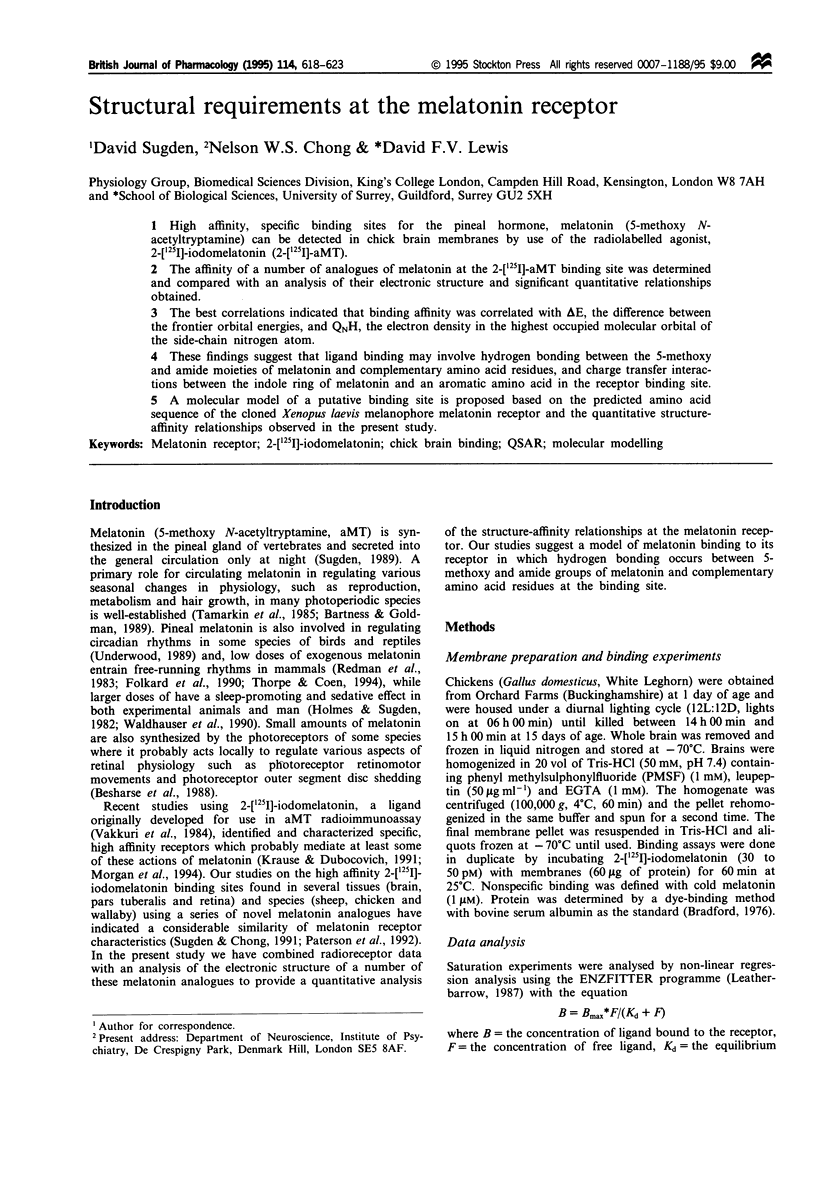
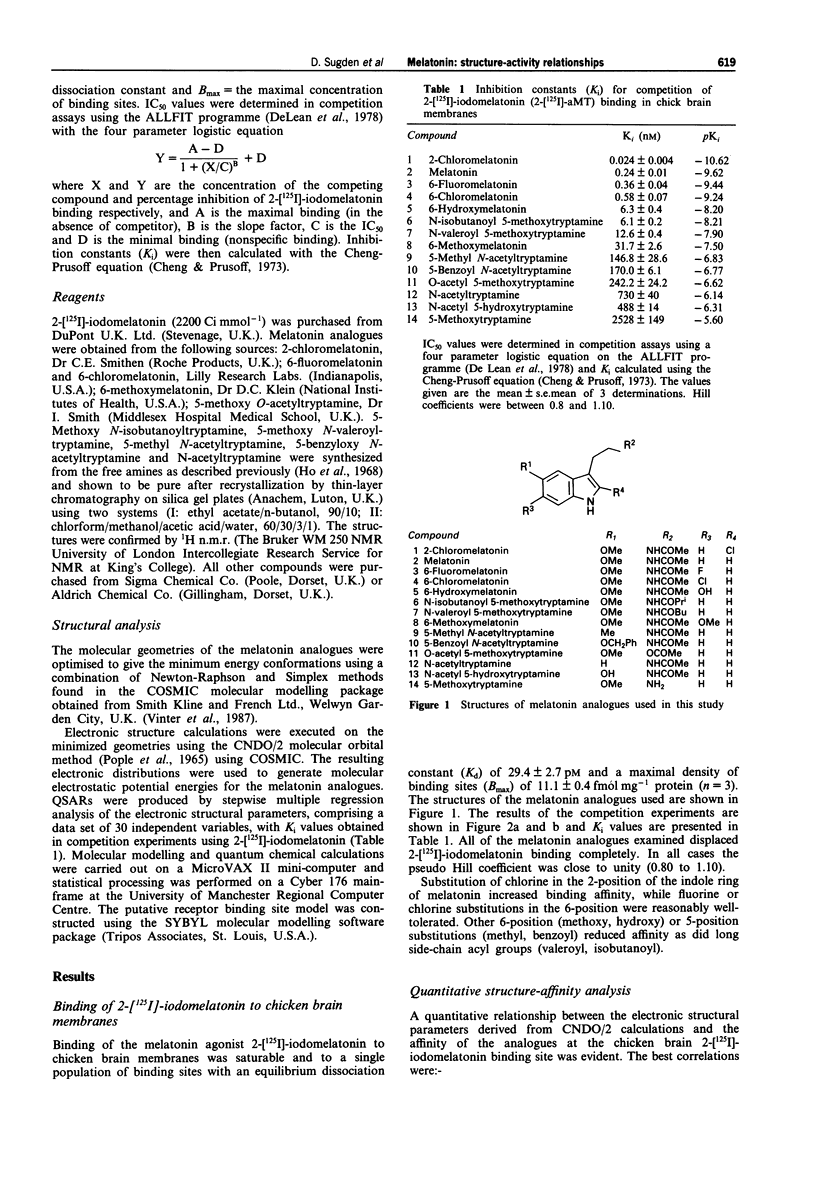
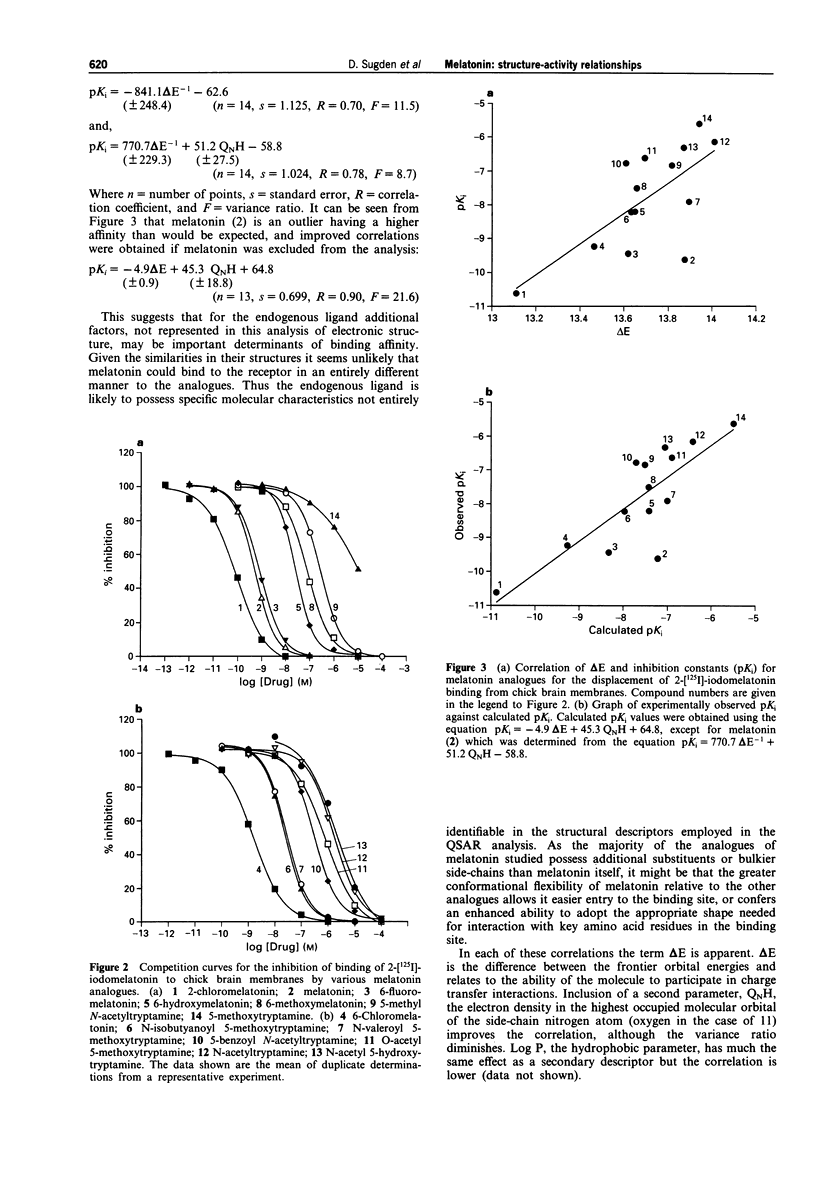
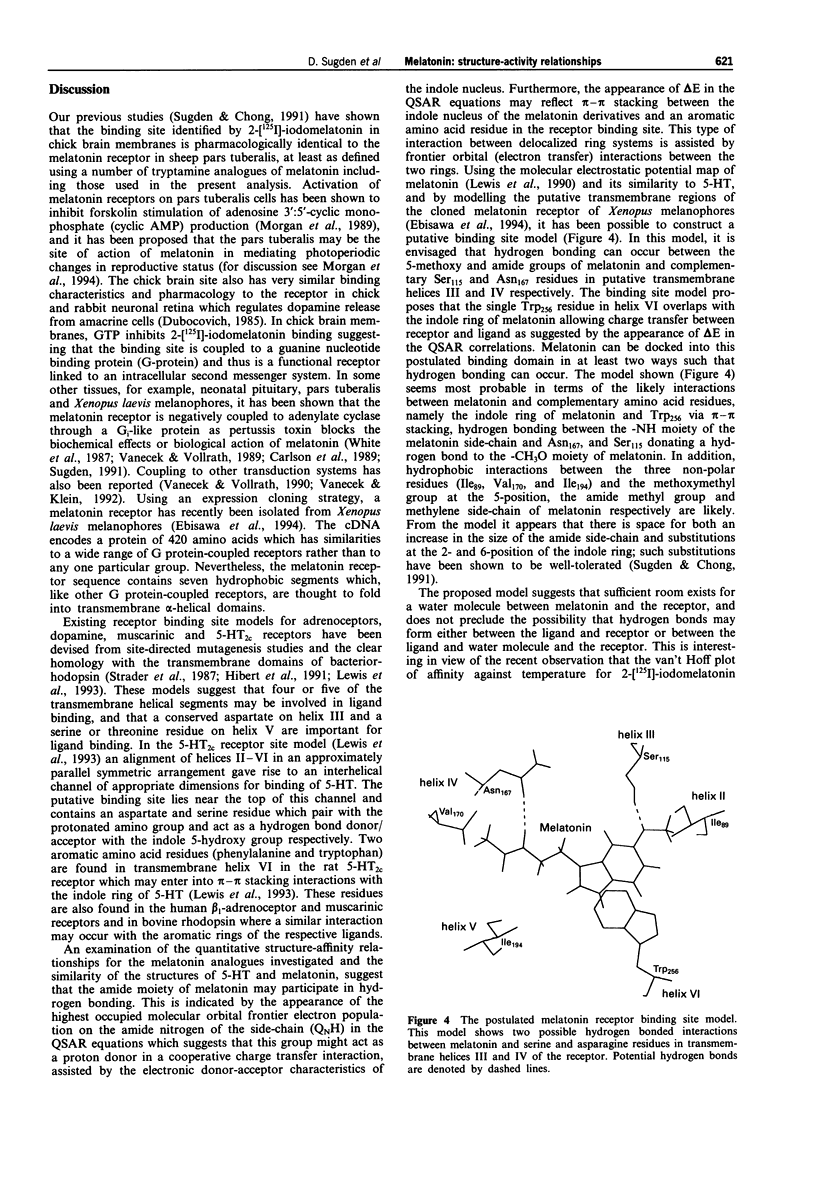
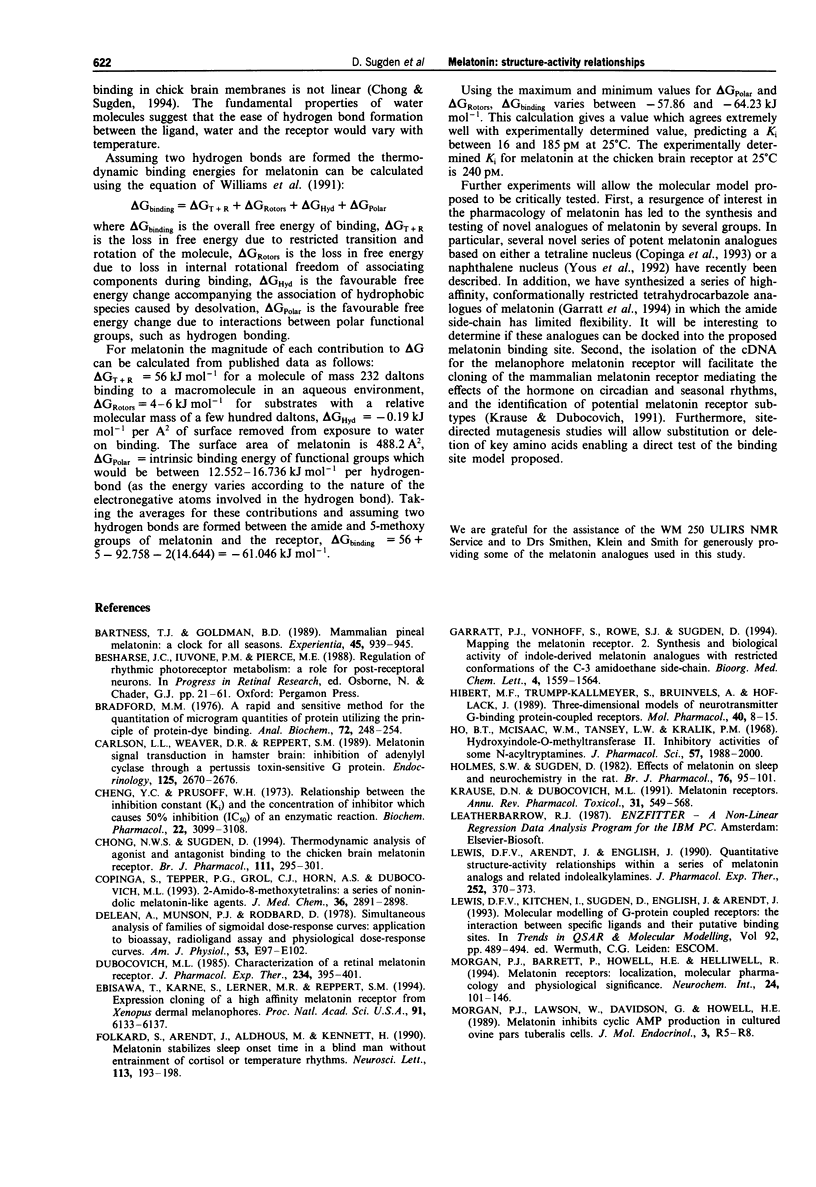
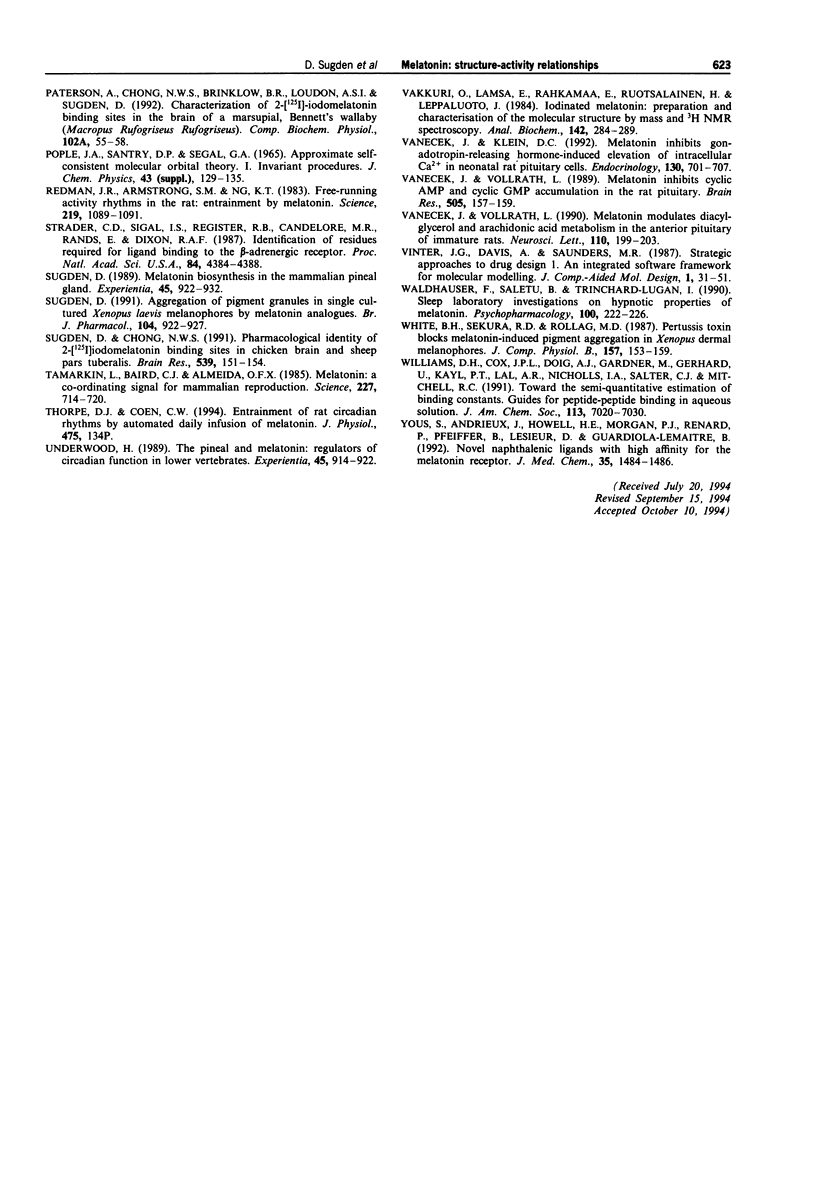
Selected References
These references are in PubMed. This may not be the complete list of references from this article.
- Bartness T. J., Goldman B. D. Mammalian pineal melatonin: a clock for all seasons. Experientia. 1989 Oct 15;45(10):939–945. doi: 10.1007/BF01953051. [DOI] [PubMed] [Google Scholar]
- Bradford M. M. A rapid and sensitive method for the quantitation of microgram quantities of protein utilizing the principle of protein-dye binding. Anal Biochem. 1976 May 7;72:248–254. doi: 10.1016/0003-2697(76)90527-3. [DOI] [PubMed] [Google Scholar]
- Carlson L. L., Weaver D. R., Reppert S. M. Melatonin signal transduction in hamster brain: inhibition of adenylyl cyclase by a pertussis toxin-sensitive G protein. Endocrinology. 1989 Nov;125(5):2670–2676. doi: 10.1210/endo-125-5-2670. [DOI] [PubMed] [Google Scholar]
- Cheng Y., Prusoff W. H. Relationship between the inhibition constant (K1) and the concentration of inhibitor which causes 50 per cent inhibition (I50) of an enzymatic reaction. Biochem Pharmacol. 1973 Dec 1;22(23):3099–3108. doi: 10.1016/0006-2952(73)90196-2. [DOI] [PubMed] [Google Scholar]
- Chong N. W., Sugden D. Thermodynamic analysis of agonist and antagonist binding to the chicken brain melatonin receptor. Br J Pharmacol. 1994 Jan;111(1):295–301. doi: 10.1111/j.1476-5381.1994.tb14059.x. [DOI] [PMC free article] [PubMed] [Google Scholar]
- Copinga S., Tepper P. G., Grol C. J., Horn A. S., Dubocovich M. L. 2-Amido-8-methoxytetralins: a series of nonindolic melatonin-like agents. J Med Chem. 1993 Oct 1;36(20):2891–2898. doi: 10.1021/jm00072a008. [DOI] [PubMed] [Google Scholar]
- DeLean A., Munson P. J., Rodbard D. Simultaneous analysis of families of sigmoidal curves: application to bioassay, radioligand assay, and physiological dose-response curves. Am J Physiol. 1978 Aug;235(2):E97–102. doi: 10.1152/ajpendo.1978.235.2.E97. [DOI] [PubMed] [Google Scholar]
- Dubocovich M. L. Characterization of a retinal melatonin receptor. J Pharmacol Exp Ther. 1985 Aug;234(2):395–401. [PubMed] [Google Scholar]
- Ebisawa T., Karne S., Lerner M. R., Reppert S. M. Expression cloning of a high-affinity melatonin receptor from Xenopus dermal melanophores. Proc Natl Acad Sci U S A. 1994 Jun 21;91(13):6133–6137. doi: 10.1073/pnas.91.13.6133. [DOI] [PMC free article] [PubMed] [Google Scholar]
- Folkard S., Arendt J., Aldhous M., Kennett H. Melatonin stabilises sleep onset time in a blind man without entrainment of cortisol or temperature rhythms. Neurosci Lett. 1990 May 31;113(2):193–198. doi: 10.1016/0304-3940(90)90302-p. [DOI] [PubMed] [Google Scholar]
- Ho B. T., McIsaac W. M., Tansey L. W., Kralik P. M. Hydroxyindole-O-methyltransferase. II. Inhibitory activities of some N-acyltryptamines. J Pharm Sci. 1968 Nov;57(11):1998–2000. doi: 10.1002/jps.2600571139. [DOI] [PubMed] [Google Scholar]
- Holmes S. W., Sugden D. Effects of melatonin on sleep and neurochemistry in the rat. Br J Pharmacol. 1982 May;76(1):95–101. doi: 10.1111/j.1476-5381.1982.tb09194.x. [DOI] [PMC free article] [PubMed] [Google Scholar]
- Krause D. N., Dubocovich M. L. Melatonin receptors. Annu Rev Pharmacol Toxicol. 1991;31:549–568. doi: 10.1146/annurev.pa.31.040191.003001. [DOI] [PubMed] [Google Scholar]
- Lewis D. F., Arendt J., English J. Quantitative structure-activity relationships within a series of melatonin analogs and related indolealkylamines. J Pharmacol Exp Ther. 1990 Jan;252(1):370–373. [PubMed] [Google Scholar]
- Morgan P. J., Barrett P., Howell H. E., Helliwell R. Melatonin receptors: localization, molecular pharmacology and physiological significance. Neurochem Int. 1994 Feb;24(2):101–146. doi: 10.1016/0197-0186(94)90100-7. [DOI] [PubMed] [Google Scholar]
- Paterson A., Chong N. W., Brinklow B. R., Loudon A. S., Sugden D. Characterization of 2-[125I]iodomelatonin binding sites in the brain of a marsupial, Bennett's wallaby (Macropus rufogriseus rufogriseus). Comp Biochem Physiol Comp Physiol. 1992 May;102(1):55–58. doi: 10.1016/0300-9629(92)90011-e. [DOI] [PubMed] [Google Scholar]
- Redman J., Armstrong S., Ng K. T. Free-running activity rhythms in the rat: entrainment by melatonin. Science. 1983 Mar 4;219(4588):1089–1091. doi: 10.1126/science.6823571. [DOI] [PubMed] [Google Scholar]
- Strader C. D., Sigal I. S., Register R. B., Candelore M. R., Rands E., Dixon R. A. Identification of residues required for ligand binding to the beta-adrenergic receptor. Proc Natl Acad Sci U S A. 1987 Jul;84(13):4384–4388. doi: 10.1073/pnas.84.13.4384. [DOI] [PMC free article] [PubMed] [Google Scholar]
- Sugden D. Aggregation of pigment granules in single cultured Xenopus laevis melanophores by melatonin analogues. Br J Pharmacol. 1991 Dec;104(4):922–927. doi: 10.1111/j.1476-5381.1991.tb12527.x. [DOI] [PMC free article] [PubMed] [Google Scholar]
- Sugden D., Chong N. W. Pharmacological identity of 2-[125I]iodomelatonin binding sites in chicken brain and sheep pars tuberalis. Brain Res. 1991 Jan 18;539(1):151–154. doi: 10.1016/0006-8993(91)90698-u. [DOI] [PubMed] [Google Scholar]
- Sugden D. Melatonin biosynthesis in the mammalian pineal gland. Experientia. 1989 Oct 15;45(10):922–932. doi: 10.1007/BF01953049. [DOI] [PubMed] [Google Scholar]
- Tamarkin L., Baird C. J., Almeida O. F. Melatonin: a coordinating signal for mammalian reproduction? Science. 1985 Feb 15;227(4688):714–720. doi: 10.1126/science.3881822. [DOI] [PubMed] [Google Scholar]
- Vakkuri O., Lämsä E., Rahkamaa E., Ruotsalainen H., Leppäluoto J. Iodinated melatonin: preparation and characterization of the molecular structure by mass and 1H NMR spectroscopy. Anal Biochem. 1984 Nov 1;142(2):284–289. doi: 10.1016/0003-2697(84)90466-4. [DOI] [PubMed] [Google Scholar]
- Vanecek J., Klein D. C. Melatonin inhibits gonadotropin-releasing hormone-induced elevation of intracellular Ca2+ in neonatal rat pituitary cells. Endocrinology. 1992 Feb;130(2):701–707. doi: 10.1210/endo.130.2.1733718. [DOI] [PubMed] [Google Scholar]
- Vanecek J., Vollrath L. Melatonin inhibits cyclic AMP and cyclic GMP accumulation in the rat pituitary. Brain Res. 1989 Dec 25;505(1):157–159. doi: 10.1016/0006-8993(89)90129-7. [DOI] [PubMed] [Google Scholar]
- Vanecek J., Vollrath L. Melatonin modulates diacylglycerol and arachidonic acid metabolism in the anterior pituitary of immature rats. Neurosci Lett. 1990 Mar 2;110(1-2):199–203. doi: 10.1016/0304-3940(90)90811-m. [DOI] [PubMed] [Google Scholar]
- Vinter J. G., Davis A., Saunders M. R. Strategic approaches to drug design. I. An integrated software framework for molecular modelling. J Comput Aided Mol Des. 1987 Apr;1(1):31–51. doi: 10.1007/BF01680556. [DOI] [PubMed] [Google Scholar]
- Waldhauser F., Saletu B., Trinchard-Lugan I. Sleep laboratory investigations on hypnotic properties of melatonin. Psychopharmacology (Berl) 1990;100(2):222–226. doi: 10.1007/BF02244410. [DOI] [PubMed] [Google Scholar]
- White B. H., Sekura R. D., Rollag M. D. Pertussis toxin blocks melatonin-induced pigment aggregation in Xenopus dermal melanophores. J Comp Physiol B. 1987;157(2):153–159. doi: 10.1007/BF00692359. [DOI] [PubMed] [Google Scholar]
- Yous S., Andrieux J., Howell H. E., Morgan P. J., Renard P., Pfeiffer B., Lesieur D., Guardiola-Lemaitre B. Novel naphthalenic ligands with high affinity for the melatonin receptor. J Med Chem. 1992 Apr 17;35(8):1484–1486. doi: 10.1021/jm00086a018. [DOI] [PubMed] [Google Scholar]


